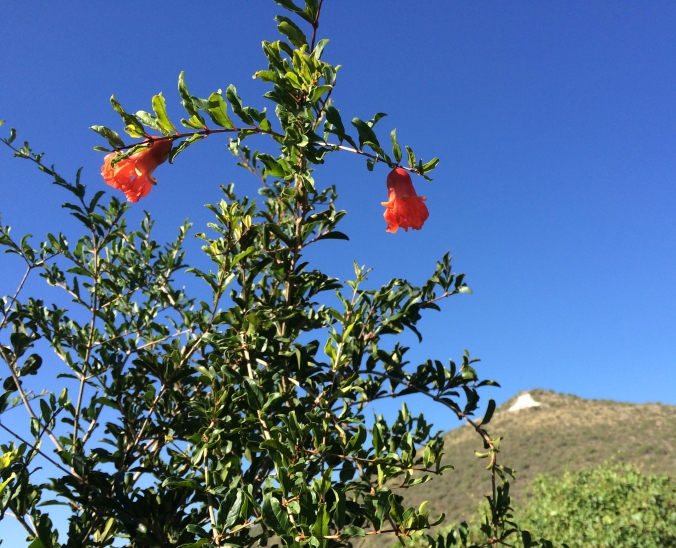
Brought by the Padres to Baja Arizona during the Mission Period over 350 years ago, this desert-adapted Sonoran White Pomegranate can continue to feed us visually, nutritionally, sustainably (photo MABurgess)
It is thought that the so-called “apple,” the fruit of knowledge of good and evil which Eve shared with Adam in the Garden of Eden, was actually a pomegranate. Now, thankfully, since Eden, we are all “fallen” and can enjoy pomegranates with no guilt! Tia Marta here, inspired deeply by the recent article in Edible Baja Arizona by Dena Cowan about the comeback of heirloom Sonora White Pomegranate being celebrated at Tucson’s Mission Garden. (This is a must-read: http://ediblebajaarizona.com/sonoran-white-pomegranate .)

Heirloom Sonora white pomegranate blooms and fruits all summer at Tucson’ Mission Garden at the base of “A”-Mountain (photoMABurgess)
One of the first joys of pomegranates is esthetic, making pomegranate (particularly our local heirloom Sonoran White) a primo candidate for edible landscaping. Its rich green foliage is cooling to eyes and spirit. Its glorious, shiny red flowers decorate the trees all summer, followed by sensuous round beige fruits that become rosy as they ripen like Christmas ornaments hanging on the tree.

Sensational flower of Sonoran White Pomegranate–an extra bonus for edible landscapers . (Check out the shape of pomegranate flowers to see the design influence in Spanish silver work which in turn inspired Dine/Navajo “squash blossom” jewelry.) (MABurgess photo)

Peeking over the wall of Cordoba House in Tucson’s historic Presidio Neighborhood is a double flowered pomegranate (MABurgess photo)

A “fallen star” –a pomegranate flower on the pavement continues as a radiant bouquet (MABurgess photo)

Prepare to share your plentiful crop of Sonoran White Pomegranate with other frugivorous creatures. True bugs like these leaf-legged bugs (Coreidae) can be pests. No prob–damage is usually limited. (MABurgess photo)
The structure of pomegranate fruits, with its separate juicy cells or arils, normally prevents insect damage from destroying an entire fruit. Just cut off the effected area and the remaining arils still will be perfect for eating.
Jesus Garcia, founder of the Kino Heritage Tree Program at Arizona-Sonora Desert Museum and Mission Garden (and traditional knowledge-keeper of important Sonoran folkways), teaches how to cut the top off of a pomegranate to clearly see the septa or membranes that separate the five or six groupings of juice cells (arils), each containing a seed. In most modern cultivated pomegranates, there is a hard bitter seed that must be “discarded,” making eating less than perfect. Amazingly, the Sonoran White has small, tender seeds that present no problem–just eat the arils whole and enjoy! (No spitting necessary.)

Subdivide the fruit along its easy membranes. This is Garcias’ traditional way of opening the Sonoran White Pomegranate for happy access to “arils” –the juicy beads or sarcotestas (MABurgess photo)
I always thought that pomme -grenade was named for the city of Granada, but actually it is the other way ’round. The Spanish city was re-named Granada when the Moors brought the fruit there from the MiddleEast and it made a big splash.
Technically the pomegranate (Punica granatum) does not have many familiar relatives to us in its family of loosestrifes (Lythraceae). It is so different from other plants that some taxonomists place it in its own family Punicaceae. Pomegranate fruit is a berry, with each seed surrounded by sweet juice in little discrete cases called sarcotestas. (There must be a better name for these delicious little beads of bliss!)
Nutritionally pomegranate has sweet advantages, providing antioxidants, folate, vitamins C and K, plus manganese, phosphorus and potassium.
Sonoran White Pomegranate can be juiced to drink straight or add to other drinks. (Talk about a nutritious addition to margaritas!) The simplest, most delightful way of enjoying our clear Sonoran White seed-cells is simply snacking by the handful.
I make a luscious dessert with vanilla yogurt topped with slices of fresh apricot, local apple, and blueberries, and crowned by the sweet seed-cells of Sonoran White Pomegranate. Rejoice in this ancient gift brought by the Missionaries to Baja Arizona–a desert survivor, well-adapted to carrying us into climate change in arid lands!

Let your Sonoran White Pomegranate fruits remain on the tree until you see a rosy blush–then you know they are getting sweetest! (MABurgess photo)
Friends of Tucson’s Birthplace will be sponsoring a Pomegranate event this month–September 24, 2016– at the Mission Garden. Come learn all about our local heirloom treasure, the Sonoran White Pomegranate, how to grow it in our own gardens, and how to prepare it in zillion delectable ways. For details call 520.777.9270 or email missiongarden.tucson@gmail.com (www.tucsonsbirthplace.org.) Let’s keep this living and giving food-heirloom alive and well in our gardens into the future!



Hi, do u sell heirloom seeds? Im from Malaysia
LikeLike
Sorry, we are not a seed company. Good luck with growing pomegranates.
LikeLike
WOW ! I had no idea that pomegranate flowers came in such variety of colors and shapes !!!! THANK YOU!
LikeLike